
Background information
CGI: computer-made cinema, part 2
by Luca Fontana

Teletext is the digital era’s answer to cave paintings. Yet it keeps on going to this day. The chance of its ongoing survival is big. It’s something I just can’t wrap my head around. So I’ve tried to get to the root of this pixel obsession.
At thirty years of age, I’m not yet one of the oldies on our editorial team (I hope they forgive me for saying this). Nonetheless, technological relics, such as VHS cassettes, disk drives and walkmans, are not mysterious remnants of yonder years to me. After all, as a 90s child, I did witness many of them. One of the relics from this time has a very special status: Teletext – the digital era’s answer to cave paintings.
I recently rediscovered the teletext button when I was testing a new TV:
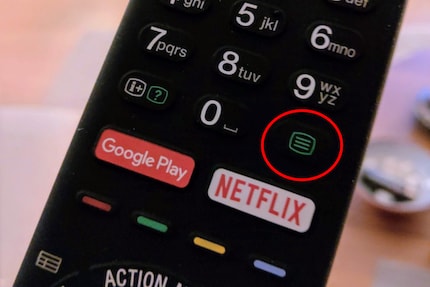
«Is this actually what I think it is,» I asked myself.
And it was. Pressing the button revealed the all too familiar: A hideous window consisting of either a white or black background, an ugly wall of text in an impossible font and, occasionally, pages with images that are so pixelated it hurts. I soon ask myself the question: Who the devil still reads teletext?
Back in the day, in the late nineties, teletext was my internet. It was where I went to get news updates and sports results, comb through the TV guide and read dirty flirt chats available on most private channels. Yep, chats existed before the internet.
They worked via SMS: For 25 cents per message, you could write exciting stuff like «sweet honey bear searching for loving honey-bun». Erm, not that I would have phrased it that way. And last but not least, there were naked pixel ladies advertising gentlemen’s entertainment. Exciting times, I’m telling you!
But once the internet hit households everywhere, I hardly ever used teletext again. And why would I? After all, I could now easily communicate with friends or read messages via MSN Messenger, Hotmail or Google. And it was all free!
This was followed by the first flat-rate ADSL offers, which brought an end to expensive phone bills and arguments with my parents, who always chose to make phone calls whenever I wanted to surf. For me, this secured teletext a place in the annals of history once and for all. Until today.
But I’ve made a mistake. I’ve assumed that everyone’s like me. However, this is not the case as numbers from Swiss broadcasting corporation SRG clearly show.
According to Francesca Guicciardi from SRG’s media office, around 500,000 people per day access the teletext service via digital media including the internet. The detailed usage numbers available on net-metrix.ch show that in the record month of February, almost 600,000 people used teletext – each user accessing it 15 times and visiting 18 pages per session. That adds up to 160 million page visits in one month. And that’s just for the teletext of SRF in the German-speaking part of Switzerland and RTS in the French-speaking part – RSI in Ticino was not part of the evaluation. That’s hardly what I’d call «dead».
I must admit, I underestimated teletext. But I still can’t make sense of it all. It’s as if I’d prefer writing this article on an old rickety typewriter than on my office PC. It’s 2018 after all.
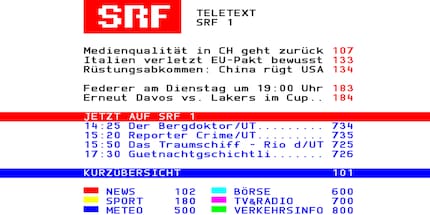
Teletext is getting on a bit. It was developed in the 70s by technicians at the BBC, who were searching for a possibility to broadcast on-demand subtitles for their TV programme. What they came up with is so-called blanking interval. This is how it works: An analogue TV image consists of 576 lines. However, 625 lines are broadcast. That’s 49 lines too many. The technicians used these to put extra information in, i.e. pixels and letters. Ta-dah!
The result: 799 pages of information in eight colours. Or: 25 lines at forty characters each. That’s a bit better than cave paintings. Just a tiny bit.
Broadcasting companies keep looking for new ways to modernise teletext. A curious product stemming from this trend is teletwitter. It involves an editorial team that sends handpicked tweets commenting on shows or the news to teletext. This allows viewers to simultaneously read comments about the TV show or news they’re watching.
Although this sounds incredibly interactive, it does beg the question if people who don’t own a smartphone even know what Twitter is.
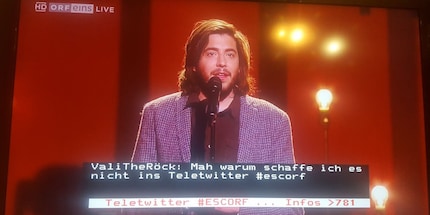
Alternatively, many broadcasters offer a text service with a more modern look. The service is then called HbbTV and sounds quite unappealing to a smartphone snob like myself. The technology aims to connect digital TV with the internet and, similarly to teletext, presents additional information including photos, videos and graphics. HbbTV is activated by pushing the red button on your remote.
It’s all meant well, but personally, I still think remotes are way too fumbly to operate. I much prefer my smartphone.

Speaking of smartphones: There exists a whole range of apps that allow you to view teletext on your mobile. You heard right. You download an app that pretends you’re looking at an analogue tube monitor; a technical relic from the early 80s. Very cutting edge, isn’t it?
In any case, it seems that many people are enjoying this blast from the past through their smartphones. According to SRG media representative Francesca Guiccardi, this translates to 284,000 nostalgia lovers per month. Things have even gone as far as to declare teletext as an art form in its own right.
In 2015, the first «International Videotext Art Festival» was held. A festival dedicated to paying homage to teletext on teletext for a full month. The event included a competition for the most beautiful teletext art.
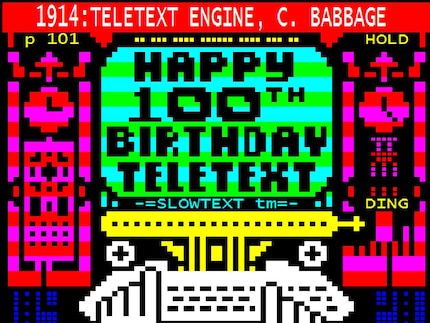
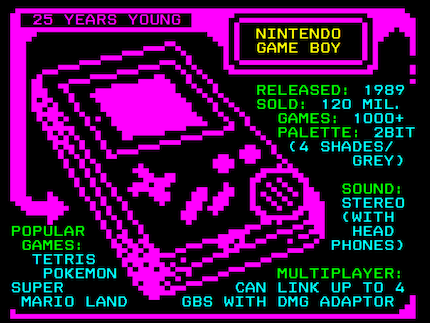
The winner was Japanese artist Ryo Ikeshiro. His page shows the famous image of Kim Kardashian and her derrière. Therefore, one can conclude that it’s officially the most beautiful image in the history of teletext.
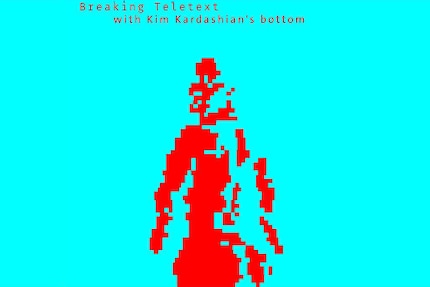
What a statement.
In a nutshell, teletext is a by-product of unused gaps in analogue TV. And it’s impractical. If I want to find a certain page, it’s a pot luck affair involving clicking through menus for hours instead of entering a specific search term in Google. Unless I’ve actually retained the three numbers that take me straight to the subject I’m interested in.
So why the hell is teletext still so popular?
Meanwhile, our editorial team is having heated debates about the purpose of pixel art and who needs it. The longer the discussions last, the more it dawns on me: Teletext is a generational matter. And the answer is not the same for everyone.
While younger generations are put off by fist-sized pixels, older generations appreciate the retro look. The young folk want slick graphics and photos; the older people get annoyed with the flurry of information around the actual information. The following two opinions stemming from our editorial team are exemplary.
Listening to David and Luca talk about teletext drives me nuts. I can’t believe there are people out there who actually download teletext to their mobiles. Granted, I don’t belong to the teletext generation. But still. There are so many better ways out there to get information quickly and easily. Minus the ugly pixelated writing. Instead, presented in an attractive and legible way and without those ominous page numbers.
She stands contrary to David, who has SRG’s teletext app on his mobile.
News websites are overloaded with ads, endless drivel and other rubbish. Why do you whippersnappers think emergency numbers have three digits? Because it’s fast. But you would probably google «ambulance emergency» first. Have fun frittering away your lives! PS: Your loss you just don’t get the 80s pixels aesthetic!
And David’s not completely wrong. Although I do know the emergency number for the ambulance, I tend to spend a lot of time googling stuff I should know. All in the name of laziness. I feel a bit like those lazy people in «Wall-E».
Time to take off my hater goggles.
Almost every home is equipped with a TV, a computer connected to the internet or a smartphone. In other words, the cave paintings from the 80s are accessible for anyone and also on-the-go. That definitely speaks for teletext. All it takes is a push of a button to receive the most relevant information such as shortnews and TV guides. And when I say short, I mean short. We’re talking no-frills information reduced to what’s essential.
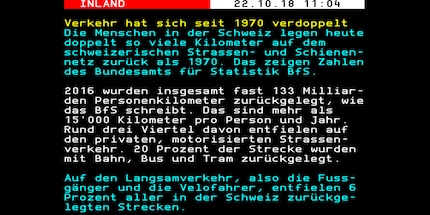
Add the above-mentioned three-digit principle for the pages and you’re basically looking at shortlinks: Sports form page 180, weather from page 500 and the current TV programme from page 700. And the private TV channels have pages dedicated to apple-shaped bottoms. It’s been that way for thirty years and will never change.
So the pot luck principle I mentioned earlier on is not fully accurate when it comes to obtaining information on teletext. As a general rule, viewers know where to find stock prices, celebrity gossip or competitions. There’s a system to teletext. And once you’ve mastered it, you’re probably faster at finding the weather forecast than I would be with my smartphone.
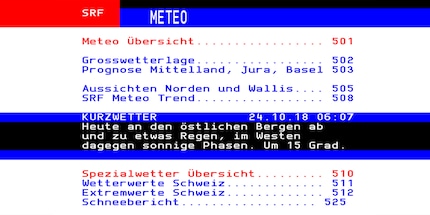
But teletext isn’t just great because it reduces everything to its essentials. It also provides subtitles for many science programmes or important political programmes, which are important for direct democracy. Or for the lyrics to the national anthem during international football matches. In other words, teletext plays an important role in giving hearing-impaired viewers access to various TV shows and important political debates.
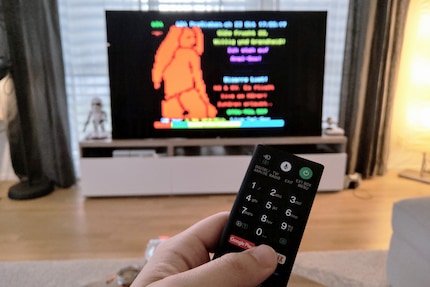
Teletext is anything but dead. In spite of Google, Twitter and Facebook. Its content is up-to-date and cuts to the chase. Visually, it’s so out of the ordinary you could call it a nostalgic antithesis to all those hipster-glam filters we’re subjected to these days. And thanks to its subtitle feature, it makes an important contribution to the inclusion of hearing-impaired individuals.
Nonetheless, it is understandable that the younger generation – and here I include myself – struggle to understand why some people prefer to use teletext in spite of the vast array of alternatives. But when it comes to generational questions, there’s no right or wrong. It’s like arguing over taste: Each to their own.
On that note: Long live teletext!
I'm an outdoorsy guy and enjoy sports that push me to the limit – now that’s what I call comfort zone! But I'm also about curling up in an armchair with books about ugly intrigue and sinister kingkillers. Being an avid cinema-goer, I’ve been known to rave about film scores for hours on end. I’ve always wanted to say: «I am Groot.»